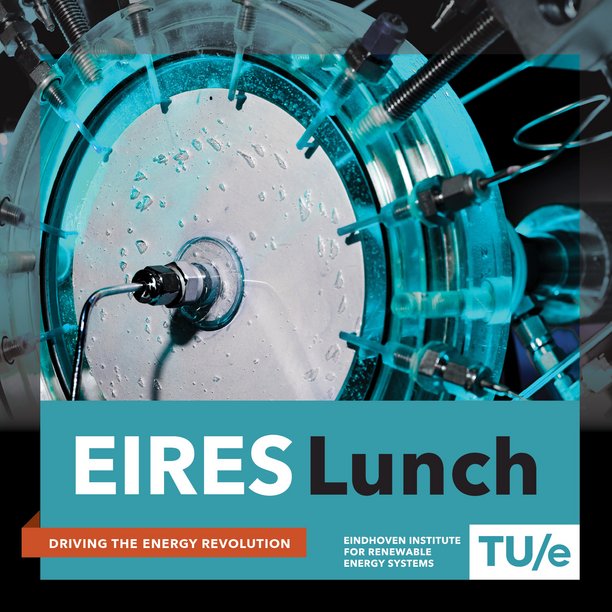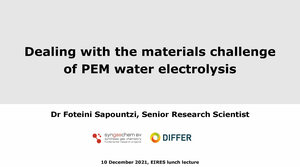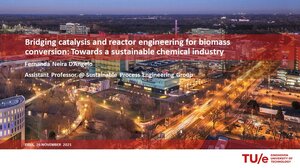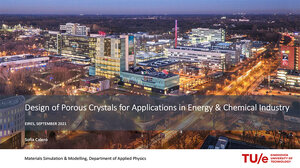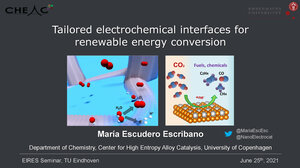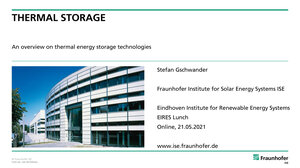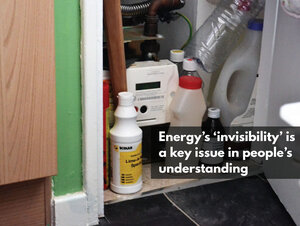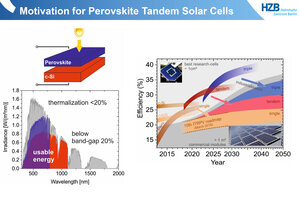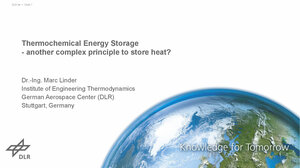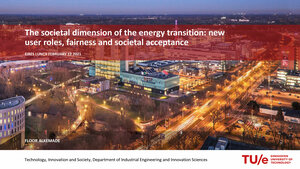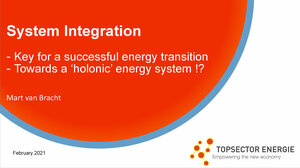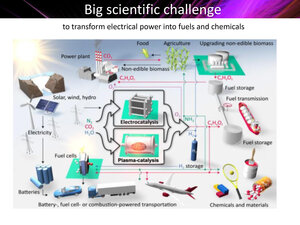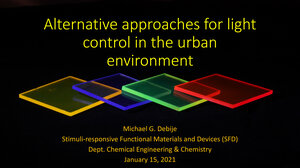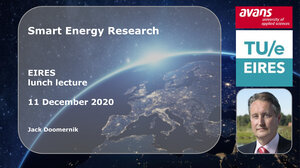EIRES Lunch | 10 December 2021
Topic & Program:
Dealing with the materials challenge of PEM water electrolysis
Organized by:
EIRES | Eindhoven Institute for Renewable Energy Systems
Led by:
Richard van de Sanden | scientific director EIRES
Foteini Sapountzi - Syngaschem BV and DIFFER
Dealing with the materials challenge of PEM water electrolysis
Hydrogen is an important energy vector and feedstock for the future CO2 neutral infrastructure. In this respect cost-effective and scalable hydrogen production by means of renewable electricity driven electrolysis is required. Proton exchange membrane (PEM) water electrolysers represent a promising technology for sustainable hydrogen production, due to their high efficiency and load flexibility. However, their acidic environment entails the use of scarce and expensive catalyst materials (Pt-based cathodes, Ir-based anodes). Apart from the associated high capital costs, the limited availability of these metals, and especially of Ir, can hinder the large-scale implementation of PEM electrolysis. There is thus an urgent need for alternative catalytic systems. In this talk Foteini Sapountzi (from Syngaschem BV and DIFFER) will present examples of her current research dealing with this challenge.
In relation to the cathode, transition metal phosphides have been identified as promising replacements for Pt. In this talk, she will discuss how such emerging electrocatalysts could be integrated to commercial-type electrodes and she will provide a performance assessment of these materials at realistic operating conditions.
In relation to the anode, low-cost replacements of Ir are not yet available and therefore the focus is put on engineering homogeneous catalyst layers at low Ir loadings. She will present a new single-step catalyst manufacturing approach based on spark ablation, which can lead to anodes with an order of magnitude improved Ir utilization and sufficient durability for industrial application.
EIRES Lunch | 26 November 2021
Topic & Program:
Bridging catalysis and reactor engineering for biomass conversion: Towards a sustainable chemical industry
Organized by:
EIRES | Focus Area - Chemistry for Sustainable Energy Systems
Led by Principal Scientists:
Adriana Creatore - Marta Costa Figueiro
Fernanda Neira d’Angelo - TU/e | Sustainable Process Engineering
Bridging catalysis and reactor engineering for biomass conversion: Towards a sustainable chemical industry
In pursuit of sustainability, the last few decades have showcased a strong commitment to replace fossil by renewable resources (i.e., biomass, wind, solar) for the production of both energy and materials. To this end, the development of new catalysts has been instrumental by unlocking chemical conversions that will shape our sustainable future. For example, catalysis allows now for the conversion of non-edible biomass (e.g., agricultural residues) into bio-based polymers and pharmaceutical products, oftentimes using renewable electricity as energy source. However, in addition to finding alternative resources and viable conversion routes, sustainability demands process efficiency to make its way towards industrial implementation. Bridging the fields of catalysis and reactor engineering, Fernanda Neira D’Angelo (from the Sustainable Process Engineering group at TU/e) develops novel and highly efficient catalytic reactors and processes for the conversion of biomass to chemicals and fuels. In her research, the relevance of numerous phenomena at different lengths-scale (i.e., active site, pore, grain, reactor and process-scales) come into play, making this quest for efficiency a complex and exciting task. In this talk, she will address selected examples of her current research in the (electro)catalytic conversion of biomass, the most important bottle-necks and recent achievements.
EIRES Lunch | 12 November 2021
Topic & Program:
Toward development of an optimum heat battery
Organized by:
EIRES | Focus Area - Systems for Sustainable Heat
Led by Principal Scientists:
Henk Huink - Silvia Gaastra-Nedea
Mina Shahi | University of Twente
Toward development of an optimum heat battery
Energy storage is a key element in energy systems based on renewable energy sources due to an increased mismatch between energy production and consumption. For the built environment the storage of heat, thermal energy, plays an important role. During this lunch lecture, Dr.Mina Shahi of the Department of Thermal and Fluid Engineering of the Twente University will first give an overview of the activities at university of Twente in the field of heat storage materials and systems, and then focus on the progress in developing a digital twin of the heat battery. She will show how an advanced numerical platform can give detailed information at different scales of the heat battery (particle-pellet-bed), and how it can be used to improve the design and efficiency of a heat battery.
EIRES Lunch | 01 October 2021
Topic & Program:
Advancing Redox Flow Batteries through Porous Electrode Engineering
Organized by:
EIRES | Focus Area - Chemistry for Sustainable Energy Systems
Led by Principal Scientists:
Adriana Creatore - Marta Costa Figueiro
Antoni Forner-Cuenca - TU/e | Chemical Engineering and Chemistry
Advancing Redox Flow Batteries through Porous Electrode Engineering
Carbonaceous porous electrodes are ubiquitous to advanced electrochemical systems where they are responsible for multiple critical functions in the cell related to thermodynamics, kinetics, and transport, including providing surfaces for electrochemical reactions, conducting electrons and heat, and distributing fluids. However, the state-of-the art arsenal of materials is limited to fibrous electrodes which have been specifically designed for low temperature fuel cells and are now repurposed, with limited success, to other emerging electrochemical systems (e.g. CO2 electrolyzers, flow batteries). Thus, there is the need to develop novel material sets with precise control over microstructure and composition, while employing synthetic methods that are compatible with large scale manufacturing. In this presentation, Antoni Forner-Cuenca will discuss his recent efforts to simulate, engineer, and synthesize tailored electrodes for redox flow batteries, which are promising for grid-scale energy storage.
EIRES Lunch | 17 September 2021
Topic & Program:
Design of Porous Crystals for Applications in Energy & Chemical Industry
Organized by:
EIRES | Focus Area - Systems for Sustainable Heat
Led by Principal Scientists:
Henk Huink - Silvia Gaastra-Nedea
Sofia Calero (TU/e - Department of Applied Physics - Chair Materials Simulation & Modelling)
Design of Porous Crystals for Applications in Energy & Chemical Industry
We use Molecular Simulation for the study and rational design of multifunctional porous materials with applications in energy and in the chemical industry. Our computational approach provides adsorptive processes designs ranging from atomistic scale to continuum scale. In this presentation I show our long-term research strategy to design and 'invent' processes based on crystalline porous materials (zeolites and Metal Organic Frameworks) that can be used for pore mouth catalysis, Fischer Tropsch, ammonia production, green hydrogen technologies, chiral separations and also to improve the Syngas industry efficiency.
EIRES Lunch | 25 June 2021
Topic & Program:
Electrocatalysis in energy conversion
Organized by:
EIRES | Focus Area - Chemistry for Sustainable Energy Systems
Led by Principal Scientists:
Adriana Creatore - Marta Costa Figueiro
Maria Escudero Escribano (Copenhagen University, Denmark)
Tailored electrochemical interfaces for renewable energy conversion
Investigating the electrochemical interface at the atomic and molecular levels is essential to understand the structure-reactivity relations and tune the active site for electrocatalytic reactions. In this lunch lecture Maria Escudero Escribano will focus on recent strategies to understand and tailor the interfacial structure and properties for renewable energy conversion. First, she will present her work on tailored electrocatalysts for oxygen reduction and evolution, from model studies to the development of high surface area nanostructured catalysts. Then, she will discuss about the role of pH and electrolyte anions on well-defined Cu electrodes for CO reduction.
EIRES Lunch | 11 June 2021
Topic & Program:
Overview of de-fossilization options for heavy-duty engines
Organized by:
EIRES | Focus Area - Engineering for Sustainable Energy Systems
Led by Principal Scientists:
Niels Deen - John van der Schaaf
Bart Somers – TU/e | Mechanical Engineering
Overview of de-fossilization options for heavy-duty engines
The lecture of Bart Somers will give an overview of the options to de-fossilize Heavy-Duty (and Marine) Internal Combustion Engines. To put it in perspective, first the two main representatives of Combustion Engines and their respective fuels are introduced. After that the many different sustainable fuels that emerge are presented and discussed in how they can be used in engines. However there exist pathways that create a win-win situation with respect to local and global emissions. Several of these sustainable fuels are excellent candidates to be applied in so-called advanced combustion concepts: Reactivity Controlled Compression Ignition (RCCI) and Partially Premixed Combustion (PPC). Extensive literature is available that report ultra-low emission levels of NOx and Soot in combination with a superior thermal efficiency (up to 59%) creating this win-win situation. Hence these concepts have been a focal point of our research and some results obtained with on our research engines will be shown.
EIRES Lunch | 21 May 2021
Topic & Program:
Thermal Storage
Organized by:
EIRES | Focus Area - Systems for Sustainable Heat
Led by Principal Scientists:
Henk Huink - Silvia Gaastra-Nedea
Stefan Gschwander - Fraunhofer Institute for Solar Energy Systems ISE
Thermal Storage
The lecture by Stefan Gschwander will give an overview on different thermal storage technologies (sensible, latent and TCM/sorption). It will compare available storage densities and will give some examples on storage systems. For both the sorption heat storage and latent heat storage, a suitable storage material with high storage density, low environmental impact and low cost is essential. Phase change slurries (PCSs) consist of a phase change material (PCM) and a carrier fluid. Depending on its state of matter the PCM is either suspended or emulsified in the carrier fluid. This facilitates the conveying of the PCS in a hydraulic system independent of the state of matter of the PCM. PCSs may be used in industrial cooling processes as heat transfer fluids as they can store a high quantity of heat within a small temperature range and can transfer the stored heat homogenously keeping a relatively steady temperature level. The usage of a fluid that stores energy and is transportable at the same time helps reducing energy losses. By dispersing the fine PCM droplets in water a high surface to volume ration is created that enlarges the heat transfer rate.
EIRES Lunch | 30 April 2021
Topic & Program:
Energy, imaginaries, design, and futures
Organized by:
EIRES | Eindhoven Institute for Renewable Energy Systems
Led by:
Richard van de Sanden | scientific director EIRES
Dan Lockton - TU/e | Industrial Design
Energy, imaginaries, design, and futures
How do you imagine and understand energy? How do you picture energy transitions happening, in everyday life? Your knowledge and expertise probably lead you to have certain ways of thinking about—and understanding—the science and the technologies, which will affect how you act. But you also know that other people, from everyday citizens to government policymakers, will have different understandings of the subject, and different visions for the future. These imaginaries (to use a term from sociology), encompassing individual mental models but also wider societal-level conceptions of technologies and futures, can influence our behaviour and practices at multiple scales. Design research offers some practical ways of investigating imaginaries (and how they affect use behaviour and practices) which can help inform the energy transition, and also ways of bringing possible futures into more experiential forms of prototype, including consideration of the human factors of interaction with technologies at an everyday scale. In this talk, Dan Lockton will offer some insights from a range of projects around design approaches to energy, behaviour, and transitions.
EIRES Lunch | 09 April 2021
Topic & Program:
Renewable approaches for chemical synthesis
Organized by:
EIRES | Focus Area - Chemistry for Sustainable Energy Systems
Led by Principal Scientists:
Adriana Creatore - Marta Costa Figueiro
Lecture by:
Bert Weckhuysen - Utrecht University
Plastics and CO2; What Can we Do?
The world is undergoing a transition trajectory to replace crude oil, coal and natural gas with alternative, more sustainable resources of energy and materials. This transition trajectory should result in a carbon-neutral society by as early as 2050, provided governmental support and related legislation will be sustained. Hence, future refineries targeting the new product slate, which is required in a more sustainable society after 2050, should use CO2 as well as agricultural and municipal waste, such as polymer waste materials as the carbon source. In this lecture, the focus will be on the search for new catalytic routes to convert CO2 as well as plastic waste into important chemical building blocks. The focus will be on thermal catalysis, electrocatalysis and photocatalysis.
EIRES Lunch | 26 March 2021
Topic & Program:
Affordable storage of renewable energy on seasonal scales
Organized by:
EIRES | Focus Area - Engineering for Sustainable Energy Systems
Led by Principal Scientists:
Niels Deen - John van der Schaaf
Basjan Dane - EMMETEnergy
Affordable storage of renewable energy on seasonal scales
Large-scale (seasonal) energy storage is the missing link for a full transition to renewable energy. EMMETEnergy proposes a reversable system which stores and extracts renewable energy in methane (synthetic natural gas). This allows for the use of the current natural gas storage infrastructure, so that a storage capacity on TWh-scale is ready available. The system operates with a reversible Solid Oxide Cell and a (catalytic) methanation unit. The system has a closed carbon loop. Due to high efficiency and reversibility we aim for storage costs less than 5 eurocents per kWh.
EIRES Lunch | 12 March 2021
Topic & Program:
Highly Efficient Monolithic Tandem Devices with Perovskite Top Cells
Organized by:
EIRES | Eindhoven Institute for Renewable Energy Systems
Led by:
- Richard van de Sanden | scientific director EIRES
- Adriana Creatore | principal scientist | EIRES | Focus Area - Chemistry for Sustainable Energy Systems
Steve Albrecht - Helmholtz-Zentrum Berlin & Technische Universität Berlin
Highly Efficient Monolithic Tandem Devices with Perovskite Top Cells
Integrating metal halide perovskite top cells with crystalline silicon or CIGS bottom cells into monolithic tandem devices has recently attracted increased attention due to the high efficiency potential of these cell architectures. To further increase the performance of these fascinating tandem solar cells to a level of predicted efficiency limits well above 30%, optical and electrical optimizations as well as a detailed device understanding of this advanced tandem architecture need to be developed. Recent results will be presented on monolithic tandem combinations of perovskite with crystalline silicon and CIGS, as well as tandem relevant aspects of perovskite single junction solar cells.
EIRES Lunch | 26 February 2021
Topic & Program:
Thermochemical Energy Storage
Organized by:
EIRES | Focus Area - Systems for Sustainable Heat
Led by Principal Scientists:
Henk Huink - Silvia Gaastra-Nedea
Marc Linder - German Aerospace Center (DLR)
Thermochemical Energy Storage - another complex principle to store heat?
During this lunch lecture Dr. Marc Linder will start with an introduction into the topic of Thermal Energy Storage thereby discussing briefly the main aspects of the storage principles and their current development status. Based on this overview the potential role of Thermochemical Storages as rather new technology will be elaborated. For this purpose we will focus on the generic principles that will help us to identify challenges but also specific features that could lead to new applications in the field of thermal energy storage and conversion. In the second part, two practical examples of recent research activities will be presented that are based on one of the specific features: the adjustable storage temperature.
EIRES Lunch | 12 February 2021
Topic & Program:
System Integration
Organized by:
EIRES | Focus Area - System Integration
Led by Principal Scientists:
Lisanne Havinga - Guus Pemen
Floor Alkemade - TU/e | IE&IS
The societal dimension of the energy transition: new user roles, fairness and societal acceptance
The EU aims for the energy transition to be socially just and to enable all consumers to profit from this transition. Moreover, meeting the goals of the Paris agreement will also require substantial changes in user behaviors in terms of energy and mobility practices. This suggests a different role and level of control and engagement for users in future energy systems. It also poses a challenge on how to engage with society in the design of more sustainable energy systems and requires seeing the user as an important element of the system. Floor outlined recent insights from the social sciences on how this can be done.
Mart van Bracht - Topsector Energy
System Integration: a necessary aspect for a successful energy transition
The framework for system integration is the energy transition. Energy system integration in this context means the integration of the entire energy value chain, where the technical, economic, social and legal sub-systems come together in one energy system. A lot of knowledge and innovation is still required for system integration. The Topsector Energy, System Integration Program, stimulates the development and dissemination of this knowledge and innovations and brings together parties that are willing and are able to successfully carry out this task.
EIRES Lunch | 29 January 2021
Topic & Program:
Decarbonizing industry with renewables
Organized by:
EIRES
Led by:
Richard van de Sanden | scientific director EIRES
Heleen de Coninck | TU/e - IE&IS - TIS (Technology, Innovation & Society)
Industry in the Netherlands and the Climate Agreement
Dolf Gielen | International Renewable Energy Agency - IRENA
Decarbonizing industry with renewables
In order to decarbonize by mid-century in line with climate goals, certain sectors are not yet receiving the attention they require, particularly industry. Feasible options exist, but are currently limited and underdeveloped. Importantly, the role of renewable options is much larger than estimated previously, with significant potential for scale-up. Critical measures for industrial decarbonization include: a massive rollout of renewable power and green hydrogen supply structure; “smart” charging and production of clean energy vectors to enable sector coupling; relocation of energy-intensive industry production steps closer to renewable sources instead of vice versa; expanded green commodity trade e.g. DRI and synthetic “powerfuels”; and global sectoral approaches or border tax adjustments for globally competing sectors, among others. European innovation is leading the way – this is critical – but Europe needs to take the rest of the world with it; action elsewhere remains limited. Progress must be accelerated urgently on multiple industrial decarbonization fronts.
EIRES Lunch | 15 January 2021
Topic & Program:
Chemistry for plasma catalysis and light control in urban environment
Organized by:
EIRES | Focus Area - Chemistry for Sustainable Energy Systems
Led by Principal Scientists:
Adriana Creatore - Marta Costa Figueiro
Evgeny Rebrov - TU/e | University of Warwick
Tunable Diode laser absorption spectroscopy (TDLAS) for ultra-fast product analysis under non-thermal plasma conditions
Applying catalysis to non-thermal plasma chemistry has become increasingly popular in recent years, with catalysts offering a degree of control over selectivity in processes which are notoriously difficult to control. Since the plasma species are short-living, the application of new ultra-fast methods with a high temporal and spatial resolution is required in the area of non-thermal plasma diagnostics. In this presentation, the application of TDLAS for 2D concentration maps in CH4 plasma will be addressed.
Michel Debije - TU/e
Alternative approaches for light control in the urban environment
Renewable energy applications deployed in the built environment have additional requirements, including the need to be aesthetically pleasing to the viewer as well as being able to generate electricity or save energy. This presentation addresses the generation of electricity from colorful plastic sheets which can be deployed where traditional solar panels fear to tread and reversibly controlling the passage of infrared light through fenestration. To improve flexibility of these devices, chemistry is exploited to enable response to changing environmental conditions like temperature, humidity, or lighting, allowing the devices to adapt themselves and adjust the fraction of infrared light reflected or change the spectrum of light passing through the window. Several potential applications will be presented to make light control elements ubiquitous to the urban setting.
Jack Doomernik | AVANS
Smart Energy Research
Jack Doomernik gave an outline about the way research is organised at Avans University of Applied Sciences and explained the way the gap is bridged between scientific research and practical application. He also introduced the Smart Energy research programme, the current research portfolio, the facilities and the collaboration with partners.
